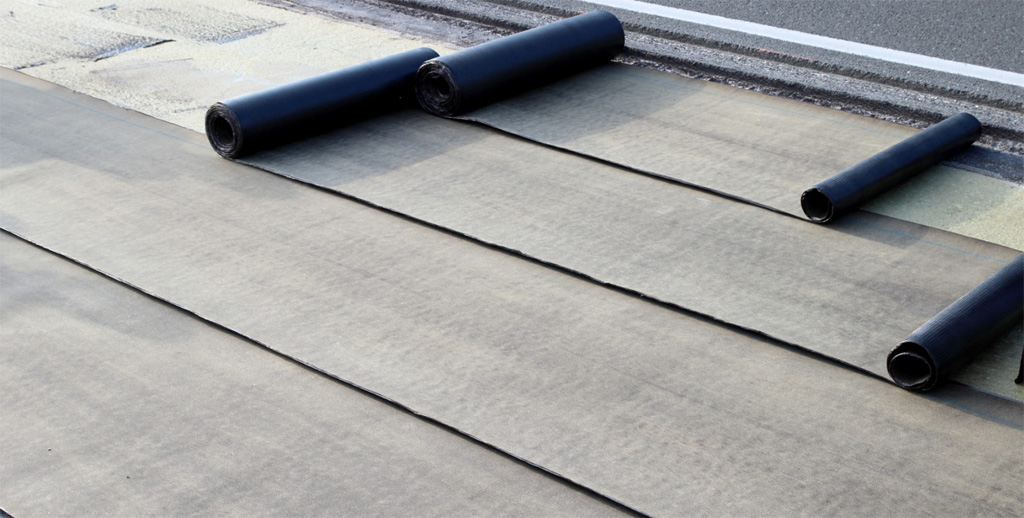Types of flat roofs

Knowing what type of flat roof you have on your building is very useful information to have when you are approaching roofing contractors, whether you are looking for a quote for routine maintenance, repairs, or a full roof replacement. Different types of flat roofs will vary widely in expected lifespan, maintenance needs, and replacement costs. Below we will look at the most common types of flat roof, and what their distinctive features are.
1. BUR or Built-Up Roofs:
You may know this style as a tar-and-gravel roof. Workers brush hot tar (asphalt tar or coal pitch) over the roof and layer strips of roofing felt into it. After several layers, the roof is finished with a final layer of tar and then covered in gravel, which protects the underlying layers from wear-and-tear and UV damage. The telltale signs of a built-up roof are evidence of brushed tar on flashing and the edges of the roof, and a uniform layer of gravel and pebbles on the roof, rather than distinct strips off.
2. Modified Bitumen Roofing
A modified bitumen flat roof is comparable to a BUR roof in that the primary materials are asphalt tar and a stabilizing substrate, however the materials are preassembled into long sheets of roofing that are usually about three feet wise. These sheets of roofing can be adhered to the underlying roof structure in several ways. Hot-applied modified bitumen roofing can be glued down with hot tar, or might need to be heated with a torch to melt the base adhesive. Cold-applied roofing may be glued down with a strong solvent-based adhesive, or may even come with adhesive pre-applied to the back of the roofing that you expose by removing a protective backing. A modified bitumen roofing can be identified by having seams every three feet or so, and the top layer of the roofing material will look granulated, not pebbly, similar to a shingle roof.
3. EPDM Rubber Roof
EPDM stands for “ethylene propylene diene monomer”, which is what EPDM roofs are made out of. It’s simpler to call them rubber roofs, however. This type of flat roofing is versatile and durable: effectively a large single sheet of rubber membrane is stretched over the underlying roof structure, and is then weighted or glued down. A ballasted roof is a method of finishing a flat roof in which the rubber sheets are held down by ballast (weight), usually stones. This type of roof might look superficially like a built-up roof, but the stones will be larger, and will not be glued down: you will be able to move them aside and expose the rubber sheeting. If the rubber roofing is glued down, it will usually be stretched tightly over and adhered to insulation or fiber board. Rubber roofs are generally easy to identify: you will see a large unbroken sheet of (usually) black rubber.
4. Spray Polyurethane Foam Roof
A spray foam roof consists of a layer of high density polyurethane foam and a waterproofing elastomeric top coat. The underlying foam layer is applied via a wand or sprayer, and you can often identify this type of roof by the evidence of the spray pattern, or how the roofing technician applied the foam. The finishing elastomer layer is generally gray or white, and if it is degraded or damaged, you will be able to see the underlying foam.
5. Thermoplastic membranes
Thermoplastic roofing membrane are single layers of material, either polyvinyl chloride (PVC) or thermoplastic polyolefin (TPO). Similar to a EPDM rubber roof, they are a single membrane roofing system, and are usually either adhered to the structure or attached with plates and screws. These membranes can be many colours but are usually white or gray, which makes them easy to distinguish from the EPDM roofing material.
Make sure you have an idea of what type of roofing system you have when you make contact with potential roofing contractors, that way they can give you a more accurate estimate for the work you want to complete.
The material you choose for a flat roof will impact your initial installation costs, the frequency with which it will need maintenance and repair, and the lifespan of the roof itself. A qualified professional roofing company can help you review your options and choose the right roof for you.

